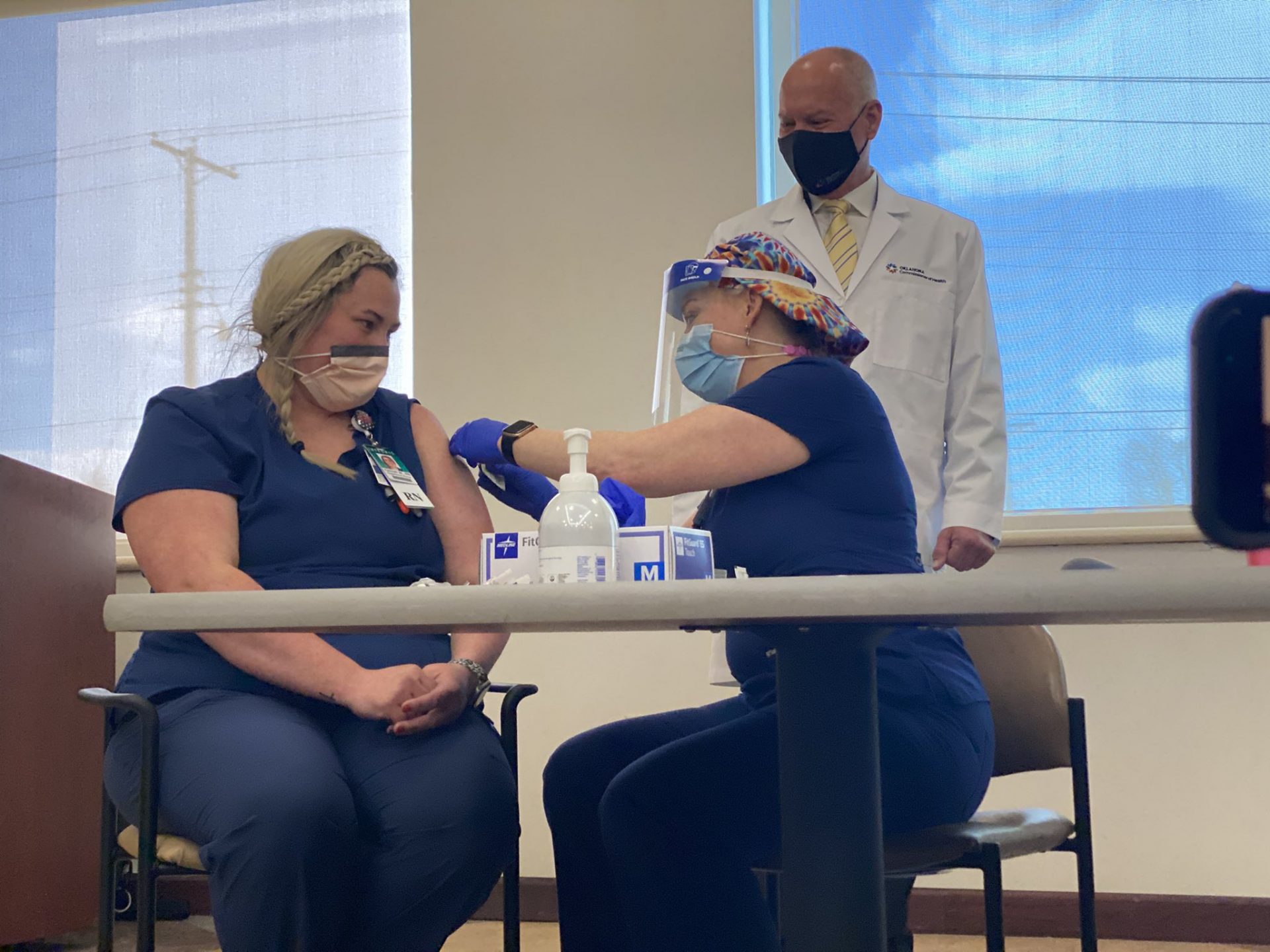
INTEGRIS Health registered nurse Hannah White becomes first Oklahoman to take Pfizer's coronavirus vaccine. Photo by The Frontier's Kassie McClung


INTEGRIS Health registered nurse Hannah White becomes first Oklahoman to take Pfizer's coronavirus vaccine. Photo by The Frontier's Kassie McClung
Oklahoma administered its first coronavirus vaccine Monday, marking a major milestone in the pandemic: what officials called the beginning of the end.
The first doses of Pfizer’s coronavirus vaccine arrived in Oklahoma on Monday morning, and the state began administering the shot to health workers at INTEGRIS Health a few hours later. That kicked off the first of four phases in the state’s vaccination plan. The first phase will cover frontline health workers, as well as nursing home staff and residents.
Several officials spoke during a press conference at the hospital, including Gov. Kevin Stitt and Oklahoma City Mayor David Holt. They celebrated the historic day and the hope that it represents, but they also reminded Oklahomans that the fight isn’t over.
“It’s going to take several months to get this vaccine out to everyone, but there is light at the end of the tunnel, so we’ve got to keep pushing hard,” Stitt said.
Holt warned against overexcitement and the false sense of security Oklahomans might develop upon seeing the vaccine in the news. He noted that it arrived amid the worst wave of the pandemic to date. Each day, Oklahoma City alone is reporting more than 1,000 new cases and 600 coronavirus hospitalizations.
“Just because you saw a nurse receive the vaccine on television does not mean that you have magically received the vaccine,” he said.
Soon after officials spoke, Hannah White, a registered nurse for INTEGRIS Health became the first Oklahoman to receive a coronavirus vaccine outside of a clinical trial.
That was the first of 33,000 Pfizer doses delivered to Oklahoma on Monday. State officials delivered nearly 8,000 doses to INTEGRIS for its workers. On the same day, nearly 10,000 went to Tulsa’s St. Francis medical system.
Each phase has subgroups, and health officials have calculated population estimates for them. For example, health care workers providing direct inpatient care for COVID-19 belong to this first phase. That includes doctors, nurses and other staff working in hospital settings such as emergency rooms and ICUs. The state’s vaccine plan states the population estimate in this subgroup is about 84,000 people.
The rest of that first priority group includes long term care residents and staff, front-line public health staff and first responders such as paramedics. All told, an estimated 157,000 Oklahomans belong to the priority group.
State health officials said they expect to receive more than 160,000 doses by the end of the year.
When it comes to timelines, those officials have been somewhat vague, reiterating that the plan is subject to change. That is especially true for the fourth and final phase of vaccinations, which will cover the general public who didn’t qualify for a priority group.
“We would love to be able to give every Oklahoman a date and time,” Deputy Commissioner of Health Keith Reed said.
But it’s not possible; the process has too many variables. For example, the state is depending on manufacturers such as Pfizer and Moderna for supply. That process has already seen hiccups. Just hours after Oklahoma announced it would get 10,000 Pfizer doses in coming weeks, the company announced that it would slash production because of supply chain issues. However, Oklahoma doesn’t appear to be one of the state’s affected.
In each press conference about the vaccine to date, officials stated their concerns about skepticism Oklahomans have expressed about the vaccine. Stitt said Monday’s press conference, in which a health professional received her shot on camera, was one of the many steps his administration is taking to drum up faith in the vaccine.
Dr. Doug Drevets, an infectious disease specialist for OU Medicine who has worked on the vaccine distribution plan, repeated that the vaccine went through the same U.S. Food and Drug Administration approval process as every other vaccine with no cut corners. He said that after reviewing those FDA documents, clinical trial materials released and interviews with Dr. Anthony Fauci, he feels confident recommending the vaccine to the public and ensuring his own family takes it.
“My job … is to give people the best advice that I can give them, including how I would treat my family,” he said.